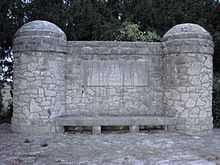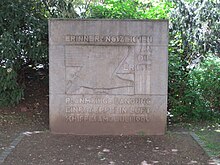Zeppelin stone
Zeppelin stones are memorial stones , which were erected as part of the zeppelin or aviation enthusiasm mainly before and during the First World War . For this purpose, natural stones ( boulders ) were often provided with an inscription or an additional plaque. In most cases, the erection of a zeppelin stone was directly related to a landing, crossing or an accident. Where it was not possible to set up a stone, other inscriptions were also used.
Pre-war airships
LZ 2
Zeppelinstein near Kisslegg
LZ 2 was driven off by a storm on its second voyage on January 17, 1906 into the Allgäu and destroyed during the emergency landing near Fischreute ( Kißlegg / Sommersried).
LZ 3 - ZI
Zeppelin stone Niederviehbach
Memorial stone near the Wastlmühle to commemorate the landing in Niederviehbach on April 1, 1909 on the long-distance journey to Munich ("Sturmfahrt") from April 1 to 3. April 1909.
LZ 4 (only build number)
Zeppelin monument on the grain sand
The Zeppelin monument on Kornsand in the Trebur district of Geinsheim in southern Hesse commemorates the emergency landing on August 4, 1908 at 5:24 p.m. With the help of the local farmers, who left their work in the fields to support the crew with the emergency landing, the vehicle was relieved of empty petrol tanks, superfluous items and operating material. Five people also had to disembark. After a five-hour break, Zeppelin, now relieved by 1270 kg, continued its journey at 10:22 p.m. The memorial was built in the form of a fortress wall made of uncut stone south of the landing stage on the right bank of the Rhine at Rhine kilometer 480.
Zeppelin stone at the land crown
Long-distance trip from 4th to 5th August 1908.
Zeppelin stone in Echterdingen
On August 5, 1908, Ferdinand Graf von Zeppelin landed on a test drive with the airship LZ 4 due to an engine failure on a meadow near Echterdingen, now a district of Leinfelden-Echterdingen . This was the first landing of an airship on solid ground. However, LZ 4 was completely destroyed there in the afternoon of the same day during a thunderstorm. The catastrophe turned out to be a stroke of luck for the airship industry, because this is where the great zeppelin donation by the German people began. It brought in over six million gold marks and enabled Count Zeppelin to continue his work on a secure financial basis. The Zeppelin stone marks the landing site near Echterdingen. It is located in the approach lane west of Stuttgart Airport approx. 1000 meters from the runway
. The design of the double-sided plaques comes from Georg Fehleisen , the casting was done by Hugo Pelargus .
![]()
LZ 5 - Z II
On August 5, 1908, he was taken over into the army, so the shipyard designation LZ 5 was dropped and the airship was officially called Z II.
Zeppelin stone and Zeppelin oak in Reinersreuth
On May 30, 1909, LZ 5 - Z II crossed the village of Reinersreuth (today part of the parish of Sparneck ) at the first attempt to drive to Berlin . On this occasion there is a memorial stone and an oak tree.
ILA landing site in Frankfurt am Main
The zeppelin stone commemorates the first zeppelin landing of the LZ 5 - Z II on the Frankfurt ILA on July 31, 1909 at 3:30 p.m. It was not until around 20 years after the ILA on November 10, 1929 that the Zeppelin memorial stone made of shell limestone was erected on the landing site in the Bockenheim district near the intersection of Am Dammgraben / Müllerstrasse.![]()
Zeppelin stone Erpeler Ley
The memorial stone near Erpel was erected to commemorate the first journey in a dirigible airship over the Rhine on August 2, 1909. LZ 5 - Z II drove from the ILA in the direction of Cologne, but had to turn back due to a storm over the Erpeler Ley .
Zeppelinstein Bad Homburg
The Zeppelin stone is a reminder of the airship parade of 1910, which was accepted by Kaiser Wilhelm II. On April 22, 1910, the airships LZ 5 - Z II (Zeppelin system), M1c (Major Hans Groß ) and P2 ( August von Parseval ) met over Bad Homburg. .
In 1913 the Zeppelin Stone was erected in the open field on Nehringstrasse at the place where Kaiser Wilhelm stood. A bronze plaque on Taunus quartzite blocks with the Latin inscription that “hic loco” (here at this location) the emperor had stood to watch the airship parade reminded of the event. In 2002, the Kur- und Verkehrsverein applied for the monument, now located in the industrial area, to be relocated to the entrance of the regional park route to Kronenhof. This relocation was rejected by the monument protection office. Only after a petition to the petition committee of the Hessian state parliament was the relocation approved, but the stone was deleted from the list of monuments. The stone was created by sculptor Stenger based on a design by Louis Jacobi . The square cast iron plate (instead of the bronze original) on a granite block from the northern slope of the Herzberg bears the (Latin) inscription in the round framed by the 12 constellations: "Wilhelm II, German Kaiser, took from three ships eight days before May 1st in 1910, who came down to earth from the area of the clouds at the same time, start the parade at this point. "
![]()
![]()
Zeppelin stone in Limburg (Hof Blumenrod)
On April 24, 1909, around 8:00 a.m., LZ 5 - Z II took off under the command of Captain von Jena with a 28-man crew on the return flight from Bad Homburg in the direction of Cologne. Due to the weather, however, it had to turn off at Rüdesheim and land south of Limburg at Hof Blumenrod in the early afternoon to refill gas. The airship was anchored to a buried cart with steel cables in order to continue the journey the next day. On April 24, 1985, a bronze plate was unveiled at the landing site in the presence of Count von Zeppelin's granddaughter, Isa von Brandstein-Zeppelin. It is a design by Berthold Conradi.
Memorial plaque in Weilburg
After the great Bad Homburg airship maneuver, the army airship started on April 24, 1910 to return to Cologne. In the early afternoon, however, the air cruiser had to go down near Limburg (Blumenrod - Alter Hof) to refill gas. The airship remained temporarily anchored here overnight. On the morning of April 25, the weather conditions deteriorated and the wind picked up again. Finally, the airship broke loose at around 1:00 p.m. and was driven off to Weilburg an der Lahn to be stranded just below what was then the “Kurhaus Webers Berg”. Then the airship had to be scrapped.
LZ 6 (only construction number - often incorrectly referred to as Z III)
Zeppelinstein Abtsdorf
The Zeppelinstein in Abtsdorf reminds of the landing of the LZ 6 - Z III on August 30, 1909. The airship came from Berlin (long-distance trip to Berlin from August 1 to September 2, 1909), but had to due to an engine defect and the loss of a propeller Land at Gut Abtsdorf. The journey to Friedrichshafen took place on September 1, 1909.
LZ 7 - Germany
Zeppelinstein on Limberg near Bad Iburg
In 1911 the Teutoburg Forest Mountain Association erected a memorial stone at the site of the accident on LZ 7 on Limberg . The bronze plaque bears the inscription Here, covered in snow, in a storm on June 28th, 1910, the first airship Z 7 'Germany' - still forward - was stranded . The relief panel was created by the Osnabrück woodcarver, modeler and sculptor Heinrich Wulfertange (1854–1924), Rudolf Wulfertange's father .
LZ 11 - Viktoria Luise
Zeppelin anchor stone Lippstadt
The Zeppelin anchor stone in Lippstadt commemorates the journey of the LZ 11 - Viktoria Luise from Düsseldorf to Lippstadt on June 2, 1912.
LZ 17 - Saxony
Zeppelinstein Wermsdorf
In 2005 a new Zeppelin stone was built near the Thiele glassworks to commemorate the landing of LZ 17 - Saxony in Wermsdorf on July 12, 1914. The stone was hewn by Kurt Müller in cooperation with Heimatverein Förderverein 800 Jahre Wermsdorf in the Wermsdorf quarry designed by Wolfgang Haubold.
War airships
LZ 101 - L 55
Zeppelinstein Tiefenort
On October 20, 1917, the naval airship L 55 under the leadership of Commander Flemming got into technical difficulties, including the radio failure. The airship rose to 7,500 meters (the existing world record to this day). The emergency landing finally succeeded in Tiefenort on the watch, after which the heavily damaged airship had to be scrapped. Parts of the fabric cover were used on site as sewing material (e.g. for aprons and sacks). In 1937, in the presence of Commandant Flemming and his crew, the memorial was inaugurated on the watch.
Zeppelin stones dedicated to Graf Zeppelin
Zeppelinstein Hiddensee / Ruegen
There are postcards with a picture of a large stone on the beach with the inscription Zeppelin 1909 . Occasionally there is a reference to a Bismarck stone. The exact location has not yet been determined; the stone has probably long been buried under the brittle cliff.
Zeppelinstein Grassau
In 1933 a memorial stone for Graf Zeppelin was erected in Grassau on the Zeppelin-Höhe .
Zeppelinstein Zepelin
The community of Zepelin in the Rostock district in Mecklenburg-Western Pomerania gave the name of the von Zeppelin family. The Zeppelin Stone was inaugurated on May 31, 1910. On the front it bears a plaque with an inscription, on the back a plaque with the coat of arms of the Zeppelin family. The plaque on the back is missing today.
Memorial inscription in Cologne
On August 5, 1909, LZ 5 - Z II was transferred to Cologne-Bickendorf for takeover by the army . Count Zeppelin, who went on board, stayed in Cologne at Herwarthstrasse 31, a memorial inscription carved into the half-timbering commemorates this.
literature
- Rainer Drewes: Schrappenpüster and Don Quixote. Rudolf Wulfertange (1884–1974) - a writer from Osnabrück. In: Heimatbund Osnabrücker Land and Kreisheimatbund Bersenbrück [Hrsg.]: Heimatjahrbuch Osnabrücker Land 2004. Georgsmarienhütte, 2003.
Web links
- Overview of zeppelin stones, monuments and the like ( Memento from December 3, 2012 in the Internet Archive )
Individual evidence
- ↑ Information about Fehleisen on a website of the city of Schwäbisch Hall , accessed on June 30, 2012
- ^ Art in Public Space Frankfurt - Zeppelin Memorial Stone ; last accessed on January 8, 2017
- ^ History of the Bad Homburg Airship Parade ( Memento from January 8, 2017 in the Internet Archive ); last accessed on January 8, 2017
- ↑ On the subject: The Zeppelin Stone - a monument without status; in: Taunuszeitung from 23 August 2012, page 13, online ( page no longer available , search in web archives ) Info: The link was automatically marked as defective. Please check the link according to the instructions and then remove this notice.
- ↑ The monument protection still lists the Zeppelinstein on its website with its old location as a monument: State Office for Monument Preservation Hesse (Hrsg.): Zeppelinstein In: DenkXweb, online edition of cultural monuments in Hesse
- ↑ http://www.weilburg-lahn.info/zeppelin/z2_10.htm
- ↑ http://www.weilburg-lahn.info/zeppelin/z2_2.htm
- ↑ Rainer Drewes: Schrappenpüster and Don Quixote. Rudolf Wulfertange (1884–1974) - a writer from Osnabrück. In: Heimatbund Osnabrücker Land and Kreisheimatbund Bersenbrück [Hrsg.]: Heimatjahrbuch Osnabrücker Land 2004. Georgsmarienhütte, 2003. ISSN 1618-5757 , p. 232 (here in the introduction about Rudolf Wulfertange's father Heinrich Wulfertange)
- ^ Zeppelin stone. Heimatverein Wermsdorf, 2015, accessed on February 16, 2017 .
- ↑ Depth location. In: rhoen.de. Retrieved February 16, 2017 .
- ↑ Ludwig Plank: The German airship journey died in America in 1937: with the explosion of Lake Hurst the age of the airships ended. In: Traunsteiner Tageblatt 24/2007 . Retrieved February 16, 2017 .








